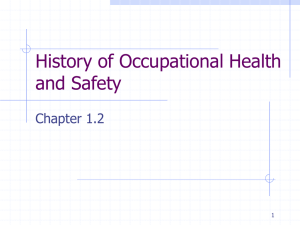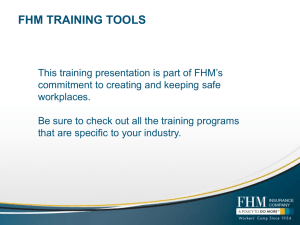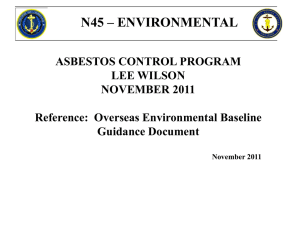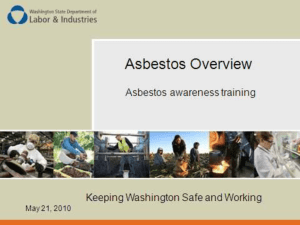Asbestos
advertisement
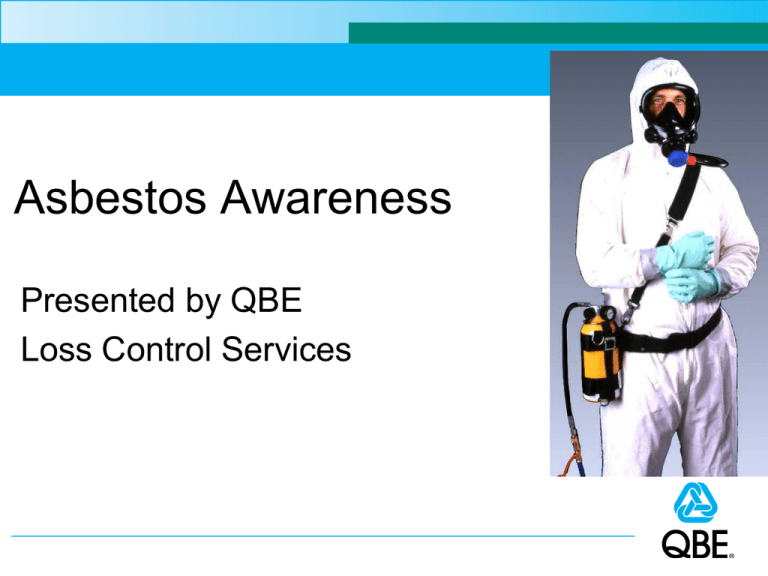
Asbestos Awareness Presented by QBE Loss Control Services Asbestos Awareness What is Asbestos ? • Generic term for various fibrous mineral silicates • Fibers very resistant to heat and chemicals and do not conduct electricity • Formerly widely used in many industries Uses of Asbestos • • • • • • 3600 commercial products Use began around 1900 Until 1940 use limited From 1940 until 1970’s used extensively After 1980 phase out began 1989- EPA phase out rule Types of Asbestos • • • • • • Chrysotile Amosite Crocidolite Tremolite Actinolite Anthophylite Chrysotile • • • • • Most common type of asbestos Heat resistant Sprayed on insulation Fireproofing Long flexible fibers easily spun into yarn Amosite • Not as common as chrysotile • Pipe and boiler insulation • Fibers easily become airborne Pipe Insulation Crocidolite • • • • Fibers shorter and more brittle High tensile strength Primarily used in cement products Fibers hard to control Common Uses • Insulating Products (1926-1971) • Surfacing Material (sprayed or troweled) (1935-1970) • Extrusion Panels (since 1930) • Transite Boards (unknown) Ceiling Tiles • Armstrong “Sanserra” • Armstrong “Santaglio” • Armstrong “Embossed Design” Roofing Materials • • • • • Shingles and clapboard (unknown) Roofing felts (since 1910) Roofing asphalt (unknown) Roof putty (unknown) Roof coatings (since 1900) Floor Materials • Mastics (1945-1980) • Asphalt tile cement (since 1959) • Vinyl asbestos tile (1950-1980) (9” x 9” tiles more likely to contain asbestos than 12” x 12” tiles) • Asphalt asbestos tile (1920-1980) Paper Products • Corrugated (1910-1980) • Indented (since 1935) • Millboard (since 1925) Other Products • • • • • • • • Caulks and putties (1900-1973) Adhesives (since 1945) Joint compound (1945-1977) Plaster/stucco (unknown) Spackles (1930-1978) Fireproofing (1935-1978) Cements (since 1900) Paints and coatings (1900-1978) Spray-on Insulation Spray-on Insulation Asbestos in Buildings • About 20% of all buildings • About 5% with sprayed or trowled on ACM (asbestos containing materials) • About 16% with ACM on pipes or boilers • Very few with ACM ceiling tiles • About 42% with ACM containing floor tiles Asbestos Related Diseases • • • • Asbestosis Lung cancer Mesothelioma Other Cancers Asbestos Fiber In Lungs Asbestosis • Lung scarring of air sacs (alveoli) • Since asbestos fibers strong, they do not break down • Asbestos fibers act as “small needles”scarring lung tissue • Scarring reduces expansion or air sacs Asbestosis Asbestosis Symptoms • • • • • • Latency 15 years Heavy difficult breathing Blue skin tone Clubbing of toes and fingers More susceptible to colds and pneumonia Victims usually die from heart failure Mesothelioma • “Asbestos Cancer” • Rare- 2000 cases per year in U.S. • Cancer of the pleura (chest cavity lining) or peritoneum (abdomen wall lining) • Small fibers enter cells causing uncontrolled growth (cancer) • Increased pressure on lungs, heart and other internal organs Mesothelioma Mesothelioma • • • • Latency 30 years Painful progressive disease 6-12 month prognosis Death by heart attack or stroke Mesothelioma Symptoms • • • • Cough, chest tightness and pains Swelling of abdomen Dramatic weight loss Stomach pains Lung Cancer • Non-smokers with asbestos exposure- 5% chance • Smoker 1-pack/day and asbestos exposure- 50% chance • Smoker 2 pack/day and asbestos exposure- 95% chance Other Disease • Cancers of colon, stomach, large intestine, esophagus • Pleural Plaques- Scars on lining of chest walls • Pleural Effusion- fluid buildup in lungs Pleural Plaques Who is at Risk from Asbestos? • • • • • • • Insulators Boiler Makers & Repairers Miners of Asbestos Ship Yard Workers Power-plant Workers Brake Line Workers Pipe Fitters Exposure Limits • ACGIH-TLV as an 8 hr. time-weighted average- 0.1 f/cc (fiber per cubic centimeter of air) • OSHA PEL as an 8 hr. time-weighted average- 0.1 f/cc (1 f/cc for a 30 min. excursion period) Exposure Factors • Concentration of fibers in air • Duration of exposure • Use of respirators and other protective measures Release of Fibers • Friable- Loose, easily released into air. Example - spray applied materials • Non-friable- Fibers not easily released into air. Example - floor tiles Friable Asbestos • Damaged ACM. • Fluffy, spray-applied fireproofing • Non-friable ACM can pose a hazard when sawed, sanded or during demolition Friable Asbestos • In most cases, intact, undisturbed ACM does not pose a health hazard. Only when disturbed does a health hazard exists. • Removal of ACM may cause a problem where none existed • In-place management may be the best control method EPA Regulations • AHERA- Asbestos Hazard Emergency Response Act -1986 Inspection and management of asbestos in schools • NESHAP- National Emission Standard for Hazardous Air Pollutants- 1973 regulates activities involving asbestos, i.e. manufacture, disposal, demolition, application, etc Asbestos Abatement OSHA • 1926.1101- Construction • 1910.1001- General Industry 29 CFR 1926.1101 • Demolition or salvage where asbestos present • Removal or encapsulation of ACM • Construction, alteration, repair and maintenance where asbestos is present • Installation of materials containing asbestos • Cleanup, transportation, disposal and storage of ACM State/Local Regulations • May have separate rules • Enforcement delegated from federal government • Training and certification required in each state or local area Contractors • Only certified contractors meeting EPA, state or local requirements allowed to perform work involving ACM Awareness • Buildings containing ACM should be abated before contractor begins work • If materials suspected of containing ACM are encountered, stop work and contact management • Wear respiratory protection in dusty situations





